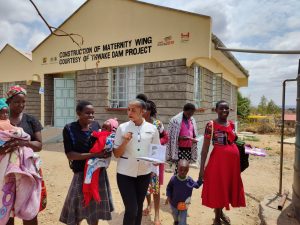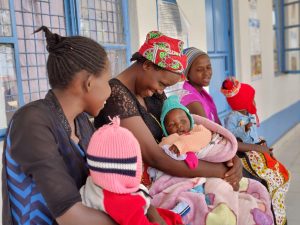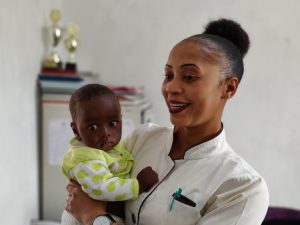Ushering dignified births
Hope for mothers as new maternity block restores safe deliveries
By Godffrey Olali
Scolastica Mwikali, 30, passionately serenades her smiling toddler baby boy even as she belts out a traditional lullaby in her native Kikamba dialect in an attempt to sooth the baby.
The mother of two, is already at the queue joining tens of other mothers who have thronged the Kathulumbi Health Center in Kathiani area of Mbooni East, Makueni County, for the weekly ante-natal and post-natal clinics at the center’s newly constructed maternity wing.
It is Tuesday mid-morning, a special mother-and-child clinic moment normally allocated per week for maternal health services and talks at the facility whose foundation stone was first laid in 1876 by then missionaries.
“This is my second born child after a ten-year gap when I got my first born. During my first pregnancy, we had no proper maternity facilities here forcing me to undertake a treacherous seven kilometer journey to Makueni County Referral Hospital in Wote Town, the only hospital where I could give birth safely,” says the soft-spoken lady whose economic activity is farming.
Mwikali’s story is similar to the tales of hundreds other mothers who are currently receiving maternal services at the facility which has seen an influx of mothers seeking services since the construction of a brand new maternity wing courtesy of Thwake Multipurpose Water Development Program’s (TMWDP) Corporate Social Responsibility (CSR) ventures.
This initiative has been spearheaded by the Ministry of Water, Sanitation and Irrigation, the contractor – China Gezhouba Group Corporation (CGGC) and the consultant – Snowy Mountains Engineering Corporation (SMEC).
Mercy Musau, the Nurse-In-Charge at this ten-bed facility is all smiles, enthusiastic and proud of the latest phenomenon.
“Before this maternity wing was constructed, we only had few women coming for delivery services, ante-natal and post-natal services because we lacked basic facilities and delivery rooms. Actually, female expectant patients were sharing same wards with male patients, a situation which compromised women’s dignity exposing them to shame and ridicule. It was chaotic, forcing most women to deliver at home posing the dangers of high mortality rates for new births,” she says.
According to the Kenya’s National Reproductive Health Policy (2022-2032), reproductive health is addressed within various policy and legislative frameworks. The Constitution of Kenya 2010 provides for the right of every person to the highest attainable standard of health including reproductive health and the right to life.
“Every woman with pregnancy-related conditions must be clinically evaluated by a qualified, experienced and registered nurse-midwife, clinical officer, medical doctor or obstetrician-gynecologist within the shortest feasible time,” the policy authored by the Ministry of Health says in part.
According to statistics by the World Health Organization (WHO), women in developing countries have, on average, many more pregnancies than women in developed countries, and their lifetime risk of death due to pregnancy is higher.
Actually, a woman’s lifetime risk of maternal death – the probability that a 15-year-old woman will eventually die from a maternal cause – is 1 in 4,900 in developed countries, versus 1 in 180 in developing countries.
 “Since the construction of this maternity wing, our main objective is the reduction of home deliveries. We want to ensure that as many women as possible visit to get the best services offered. When these women come to the facility, we also train them on basic maternity wellness issues including nutrition, danger signs of pregnancy, severe pressure and bleeding during pregnancy, fatigue, sweating and other ante-natal and post-natal talks,” says Mercy.
“Since the construction of this maternity wing, our main objective is the reduction of home deliveries. We want to ensure that as many women as possible visit to get the best services offered. When these women come to the facility, we also train them on basic maternity wellness issues including nutrition, danger signs of pregnancy, severe pressure and bleeding during pregnancy, fatigue, sweating and other ante-natal and post-natal talks,” says Mercy.
The medic, who manages the center which also comprises of four other nurses, one laboratory technician, one peer educator, and two community health volunteers, adds that since the maternity wing was constructed, some women come as far as Kitui Rural area which borders the dam to access clinics and deliver babies here.
“Maternal health refers to the health of women during pregnancy, childbirth and the postpartum period. The major causes of maternal morbidity and mortality include hemorrhage, infection, high blood pressure, unsafe abortion, and obstructed labour. This new maternity wing has given us a lot of hopes with the increase in women coming to seek our services, thanks to Thwake Multipurpose Water Development Program,” adds the medic.
Her sentiments are echoed in a document authored by the World Health Organization (WHO) which reveals that every day, approximately 830 women die from preventable causes related to pregnancy and childbirth.
Ninety-nine per cent of all maternal deaths occur in developing countries. Maternal mortality is higher in women living in rural areas and among poorer communities, while young adolescents face a higher risk of complications and death as a result of pregnancy than other women.
“Skilled care before, during and after childbirth can save the lives of women and newborn babies. This facility now caters for over 100 families including other isolated cases of teenage pregnancies which are being recorded in the area,” adds Mercy.
The Kathulumbi facility has since grown to Level Three with other services such as family planning, immunization, both in-and-out patient, laboratory services and comprehensive care for people living with HIV Aids.
“We have also experienced cases of teenage pregnancies as well within the communities around. However, we have formulated workable strategies where we conduct outreach services in girls’ schools with the support from the government through local administration. At our facility, we normally engage young girls in talks on dangers of peer pressure and demerits of unwanted pregnancies,” she says, thanking the government for introducing the Edu Afya Medical Card for learners.
However, we have formulated workable strategies where we conduct outreach services in girls’ schools with the support from the government through local administration. At our facility, we normally engage young girls in talks on dangers of peer pressure and demerits of unwanted pregnancies,” she says, thanking the government for introducing the Edu Afya Medical Card for learners.
The Ministry of Education contracted National Hospital Insurance Fund (NHIF) to offer a unique comprehensive medical insurance cover for public secondary school students.
According to the medic, adolescent health constitutes an ongoing challenge. Childbearing begins early in Kenya, with almost one-quarter of women having given birth by age 18 and nearly half had started childbearing by age 20.
Kenya is projected to experience a significant increase in demand for reproductive health services as the nation continues to increase life expectancy with close to a quarter of her population being adolescents.
Even though the literacy level is a bit low within the communities in Mbooni area, Mercy says that they have devised a mechanism to create awareness and ensure mothers are well educated on maternal health matters.
“The literacy level is not very high in this area. This is why we apply the use of Information, Education and Communication (IEC) pictorial advocacy materials which are normally translated so that the women and other villagers can consume the information properly. This strategy has worked so well because our Community Health Volunteers (CHV) normally with the assistance of local administration, chiefs and their assistants, conduct door-to-door campaigns to educate the mothers,” she says.
Godffrey is the Senior Communications Specialist for the program

